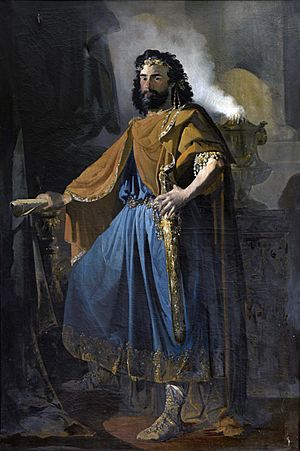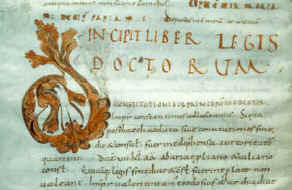Code of Euric facts for kids
The Codex Euricianus (say: Koh-dex Yoo-ri-see-AH-nus), also known as the Code of Euric, was a very important collection of laws for the Visigoths. The Visigoths were a powerful Germanic people who settled in parts of Europe. This law book was created by order of their king, Euric, sometime before the year 480 AD. It was likely put together in cities like Toulouse or Arles.
The Code of Euric is one of the earliest examples of early Germanic law. It was written down by a Roman lawyer named Leo, who was a main advisor to King Euric. The laws in the code mixed old Visigothic customs with ideas from Roman law. It showed how the Visigoths were becoming more like the Romans in their way of life.
The code also clearly showed the different groups of people in Visigothic society. There were lords, who were like bosses over others. Below them were two types of free people: the buccellarii and the saiones. The buccellarii were like knights or warriors who served a lord. They could change lords, but they had to give back any land they had received from their old lord. This law code was the first time the buccellarii were officially recognized in law.
The Codex Euricianus covered many different topics. It had rules about arguments over land borders and how land was divided between the Visigoth conquerors and the Roman landowners. It also included laws about lending money, buying and selling things, giving gifts, marriage, and who would inherit property after someone died. Experts see it as a groundbreaking achievement for Germanic law. Even though it was for the Visigoths, much of the law in the code came from Roman legal ideas.
Laws and Society
The Codex Euricianus helped to organize the Visigothic kingdom. It showed how King Euric wanted to create a clear system for everyone.
Land and Property
One of the main goals of the code was to manage how land was shared. When the Visigoths settled in new areas, they often took land from the Romans who lived there. The code set rules for how this land division should happen. This helped to prevent arguments and keep peace between the different groups of people. It also had rules for everyday dealings like buying, selling, and lending.
Family and Inheritance
The code also included important laws about family life. It had rules for marriage, which was a big part of society. It also explained how property would be passed down when someone died. These laws helped to keep families stable and ensure that property was handled fairly.
Later Laws
The Codex Euricianus was very important for future laws. Parts of it were later used in other law collections. For example, some of its ideas can be found in the Lex Baiuvariorum, which was the first law code for the Bavarians. Other Germanic law codes, like those of the Burgundians and Franks, were also influenced by Euric's code.
After King Euric died, his son, Alaric II, continued to use and expand these laws. Alaric II added another important law book called the Breviary of Alaric. Both the Code of Euric and the Breviary of Alaric were used for a long time.
These laws stayed in use until the Visigoths finally settled in Spain. There, King Liuvigild (who ruled from 568 to 586 AD) created a new set of laws called the Codex Revisius. However, this new code has been lost over time.
Much later, in 654 AD, a more complete set of laws was introduced. This was called the Lex Visigothorum. Unlike the Codex Euricianus, which often dealt with problems between different groups of people, the Lex Visigothorum applied to everyone in the territory. It became the main law for the entire Visigothic kingdom.
See also
 In Spanish: Código de Eurico para niños
In Spanish: Código de Eurico para niños
- Early Germanic law
- Lex Visigothorum, 654



